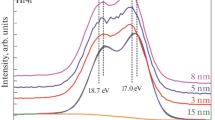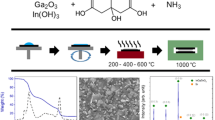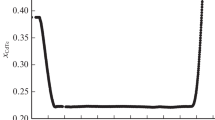Abstract
The amphoteric model of As in HgCdTe is the basis of an investigation into how the transfer \({\hbox{A}\dot{\hbox{s}}_{\rm Hg} {\rightarrow} \hbox{As}^{\prime}_{\rm Te}}\) is achieved under Hg saturation and so obtain a method for calculating optimum annealing times for the transfer. It is concluded that Schaake’s assumption that the transfer, or activation, process is diffusion limited, rather than reaction-rate limited, is a better fit to experimental data. The identification of the Te self-diffusivity in HgCdTe as due to Te i defects is considered to be incorrect. As a result, Schaake’s activation model can only underestimate the optimum anneal times for \({\hbox{As}^{\prime}_{\rm Te}}\) activation if the experimentally observed Te self-diffusivity is used. An equation based on experimental activation data is given that permits an estimate of the optimum anneal time to be obtained in \({x_{\rm Cd} \sim 0.3}\) HgCdTe layers.





Similar content being viewed by others
References
H.R. Vydyanath, J.A. Ellsworth, C.M. Devaney, J. Electron. Mater.16, 13 (1987)
P. Capper, D. Shaw, Proc. SPIE 6294, 6294MO (2006)
S. Shin, J.M. Arias, M. Zandian, J.G. Pasko, L.O. Bubulac, R.E. De Wames, J. Electron. Mater. 24, 609 (1995)
M.A. Berding, M. van Schilfgaarde, A. Sher, Phys. Rev. B 50, 1519 (1994)
D. Shaw, P. Capper, J. Mater. Sci.: Mater. Electron. 11, 169 (2000)
H.F. Schaake, J. Appl. Phys. 88 1765 (2000), J. Electron. Mater. 30 789 (2001)
D. Shaw Properties of Narrow Gap Cadmium-based Compounds EMIS Datareview series No. 10, ed. by P. Capper (London, UK: INSPEC/IEE, 1994) Chapter A4.1
J.C. Clark, E.D. Jones, Properties of Narrow Gap Cadmium-based Compounds EMIS Datareview series No. 10, ed. by P. Capper (London, UK: INSPEC/IEE, 1994) Chapter B4.1
J.C. Brice, Prog. Cryst. Growth Charact. 13, 39 (1986)
H.R. Vydyanath, J. Vac. Sci Technol. B 9, 716 (1991)
M. Neubert, K. Jacobs, R. Krause-Rehberg, Th. Abgarjan, P. Gille,W. Hoerstel, J. Appl. Phys. 79, 7563 (1996)
D. Chandra, M.W. Goodwin, M.C. Chen, J.A. Dodge, J. Electron. Mater. 22, 1033 (1993)
D. Chandra, M.W. Goodwin, M.C. Chen, L.K. Magel, J. Electron. Mater. 24, 599 (1995)
D. Shaw, Semicond. Sci. Technol. 15, 911 (2000)
D. Shaw, Semicond. Sci. Technol. 11, 55 (1996)
D. Shaw, Semicond. Sci. Technol. 9, 1729 (1994)
H.R. Vydyanath, Semicond. Sci. Technol. 5, S213 (1990)
M. Berding, A. Sher, M. van Schilfgaarde, A.C. Chen, J. Arias J. Electron. Mater. 27, 605 (1998)
M. Berding, A. Sher, Appl. Phys. Lett. 74, 685 (1999)
S. Sivananthan, P.S. Wijewarnasuriya, F. Aqariden, H.R. Vydyanath, M. Zandian, D.D Edwall, J.M. Arias, J. Electron. Mater. 26, 621 (1997)
A.C. Chen, M. Zandian, D.D. Edwall, R.E. de Wames, P.S. Wijewarnasuriya, J.M. Arias, S. Sivananthan, M. Berding, A. Sher, J. Electron. Mater. 27, 595 (1998)
D.D. Edwall, P. Piquette, J. Ellsworth, J. Arias, C.H. Swartz, L. Bai, R.P. Tompkins, N.C. Giles, T.H. Myers, M. Berding, J. Electron. Mater. 33, 752 (2004)
D. Chandra, D.F. Weirauch, H.F. Schaake, M.A. Kinch, F. Aqariden, C.F. Wan, H.D. Shih, J. Electron. Mater. 34, 963 (2005)
D. Shaw, J. Cryst. Growth 86, 778 (1988)
B.E. Deal, A.S. Grove, J. Appl. Phys. 36, 3770 (1965)
H. Schaake, D. Chandra, M.A. Kinch, F.A. Aqariden, H.D. Shih, II-VI Workshop (Newport Beach, CA, 2006)
D. Shaw, J. Phys. C: Solid State Phys. 17, 4959 (1984)
Author information
Authors and Affiliations
Corresponding author
Appendices
Appendix 1
Schaake’s numerical solution to the diffusion equation describing As′Te activation [6] also provided the empirical relation valid for z ≤ 0
where z = ln β, c Te(∞) and c Te(L,t) are the As′Te concentrations at the layer surface and at the layer/substrate interface after anneal time t, respectively. Schaake assumed that c Te(0,t) = c Te(∞), i.e. the surface concentration rapidly attains its equilibrium value, c Te(∞). The activation level or efficiency is ≥ c Te(L,t)/c As or c Te(L,t)/c Te(∞) as under annealing at Hg saturation c Te(∞) is essentially equal to c As.
Appendix 2
A common feature in the II–VI semiconductors, such as ZnSe, CdS, CdSe, CdTe and MCT (x Cd = 0.2), is that the anion tracer self-diffusivity is ∝ the reciprocal of the Zn, Cd or Hg partial pressure [24]. A straightforward interpretation of this dependence is that self-diffusion is due to the neutral anion interstitial. It has also been noted, however, that the reciprocal pressure dependence could also arise through an anion anti-site defect diffusing via alternating jumps into cation and anion vacancies [27]. The treatment in [27] is a general one and applied to the MCT case becomes:
-
(i)
The TeHg tracer jumps into an adjacent VTe at a rate ∝ [VTe];
-
(ii)
The TeTe tracer now jumps into an adjacent VHg at a rate ∝ [VHg] so that the tracer TeHg has now made an overall jump to a nearest-neighbour site on the cation sub-lattice via consecutive jumps between the two sub-lattices;
-
(iii)
The overall jump rate will be determined by the slower of the rates in (i) and (ii);
-
(iv)
Assume that (i) is the slower and that the VTe involved is the neutral charge state so that the overall jump rate of the TeHg tracer is ∝ P Hg;
-
(v)
The diffusivity of the TeHg tracer is therefore ∝ P Hg;
-
(vi)
The Te self-diffusivity due to TeHg is ∝ [TeHg]P Hg;
-
(vii)
Assume that it is the neutral charge state of the TeHg that is mobile so that [TeHg]∝ 1/P 2Hg and the Te self-diffusivity is then ∝ 1/P Hg, as found experimentally.
There is no obvious way in which the observed 1/P Hg dependence can be accounted for in terms of ionised native defects and be consistent with known electrical behaviour.
Rights and permissions
About this article
Cite this article
Shaw, D., Capper, P. Activation kinetics of the As acceptor in HgCdTe. J Mater Sci: Mater Electron 19, 67–73 (2008). https://doi.org/10.1007/s10854-007-9269-6
Received:
Accepted:
Published:
Issue Date:
DOI: https://doi.org/10.1007/s10854-007-9269-6




